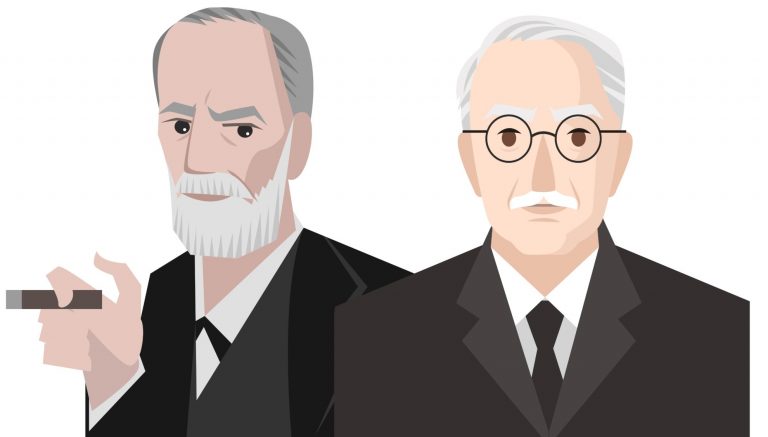Sigmund Freud and Carl Gustav Jung

An artistic depiction of the two notable psychiatrists, Sigmund Freud (left) and Carl Jung (right)
Table of Contents
Sigmund Freud
Sigmund Freud was a famous Austrian neurologist (1856 – 1939), who stated that dreams were the manifestation of the unconscious. Himself and another neurologist, Carl Gustav Jung (1875 – 1961), believed that conscious behavior derived from unconscious instinct which exists in all of us.
These unconscious thoughts were linked to suppressed sexual desires. Freud identified three key stages in the life cycle where the child’s tendency to focus on sexual areas of the body changes over time.
- In the first year of a babies’ life, they focus on the mother’s mammary gland for feeding (the breast).
- This state is succeeded from age 1 to 3 where the toddler is learning how to control their bowel and concentrates on their anal region.
- This is in turn succeeded by attention towards the reproductive organs at age 3 to 4.
Freud argued that in these stages of unconscious repression, male children are attracted to their mother and become instinctively aggressive towards the father. The father reciprocally injects fear into the child by his male superiority, thus insinuating an essence of competition and games theory. Either way, the prime fact is that the child must grow to become sexually active and mature.
Differences Between Jung and Freud
Jung believed that a persons’ brain consisted of the forgotten consciousness and a cluster of memories of past experiences. He came to this hypothesis by studying humans suffering a mental disorder, who had hallucinations that were not a past recollection, thus Jung deduced there was another component of the brain adding to this illusion, i.e. the unconscious.
Freud, on the other hand, believed that the brain was divided into three parts
- The ID – Inherited natural instincts
- The Ego – The sense of self and attitude towards the external environment
- The Superego – Superimposed values deriving from society and parental guidance
Essentially, this method of thinking, and approaching the brain from a self-realizing approach, neurology has been able to develop since these initial theories by Jung and Freud.
It also paved advances in psychiatry, and methods of psychotherapy to combat mental disorders, which are investigated upon in the next tutorial.
You will also like...

Pollution in Freshwater Ecosystems
There are many environmental factors that arise due to the usage of water in one way or another and for every action tha..

Freshwater Community Energy Relationships – Producers & Consumers
This tutorial looks at the relationship between organisms. It also explores how energy is passed on in the food chain an..

Darwin and Natural Selection
This tutorial investigates the genetic diversity in more detail. It also delineates how certain alleles are favored over..

Soils
Nutrients in the soil are essential to the proper growth of a land plant. This tutorial deals with the properties of soi..

Cell Structure
A typical eukaryotic cell is comprised of cytoplasm with different organelles, such as nucleus, endoplasmic reticulum, G..

Meiosis and Alternation of Generations
Plants are characterized by having alternation of generations in their life cycles. This tutorial is a review of plant m..
